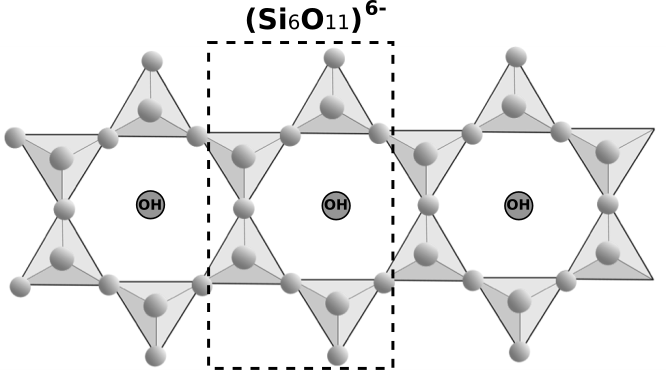
Amphibole silicate structure has an 'x' number of corners shared per tetrahedron. The value of 'x' is
A.
B.
C.3
D.4
Answer
491.7k+ views
Hint: Amphiboles refer to common rock-forming silicates which have hydroxyl groups in their structure and are considered to be hydrous silicates that are stable only in hydrous environments where water can be incorporated into the structure as
Complete step by step answer:
It has already been established that amphibole silicate structure has an 'x' number of corners shared per tetrahedron. The value of 'x' is

Additional information: Other important types of silicates found in nature include:
Orthosilicates (or Nesosilicates): The ortho silicate ion is the strong conjugate base of weak orthosilicic acid as well as it will not persist in aqueous solutions. In nature, ortho silicates are rare and only found with cations which form highly insoluble salts.
-Pyro silicate (or Sorosilicates)
-Cyclic silicates (or Ring silicates)
-Chain silicates (or pyroxenes)
-Double chain silicate (or amphiboles)
-Sheet or phyllosilicates
-Three dimensional (or tecto) silicates
Note:
The chemical composition of amphibole silicates can be shown by the general formula:
For most amphibole silicates the combination of the prismatic form and two diamond-shaped directions of cleavage at about
Complete step by step answer:
It has already been established that amphibole silicate structure has an 'x' number of corners shared per tetrahedron. The value of 'x' is

Additional information: Other important types of silicates found in nature include:
Orthosilicates (or Nesosilicates): The ortho silicate ion is the strong conjugate base of weak orthosilicic acid as well as it will not persist in aqueous solutions. In nature, ortho silicates are rare and only found with cations which form highly insoluble salts.
-Pyro silicate (or Sorosilicates)
-Cyclic silicates (or Ring silicates)
-Chain silicates (or pyroxenes)
-Double chain silicate (or amphiboles)
-Sheet or phyllosilicates
-Three dimensional (or tecto) silicates
Note:
The chemical composition of amphibole silicates can be shown by the general formula:
For most amphibole silicates the combination of the prismatic form and two diamond-shaped directions of cleavage at about
Recently Updated Pages
Master Class 11 Economics: Engaging Questions & Answers for Success

Master Class 11 Business Studies: Engaging Questions & Answers for Success

Master Class 11 Accountancy: Engaging Questions & Answers for Success

Express the following as a fraction and simplify a class 7 maths CBSE

The length and width of a rectangle are in ratio of class 7 maths CBSE

The ratio of the income to the expenditure of a family class 7 maths CBSE

Trending doubts
State and prove Bernoullis theorem class 11 physics CBSE

What are Quantum numbers Explain the quantum number class 11 chemistry CBSE

Write the differences between monocot plants and dicot class 11 biology CBSE

1 ton equals to A 100 kg B 1000 kg C 10 kg D 10000 class 11 physics CBSE

State the laws of reflection of light

In northern hemisphere 21st March is called as A Vernal class 11 social science CBSE




